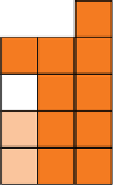Geology Reference
In-Depth Information
Oxidized sulfur compounds
A great many metals of economic importance are
deposited from hydrothermal fluids in the form of
sulfide minerals (Box 9.8). The other Group VI
elements,
selenium
(Se) and
tellurium
(Te), may take
the place of sulfur in such minerals. A number of sele-
nide and telluride minerals are known.
Sulfides are not stable in contact with atmospheric
oxygen. H
2
S is rapidly oxidized, in water to the sulfate
anion SO
4
2−
(if sufficient dissolved oxygen is present)
and in air to gaseous sulfur dioxide (SO
2
, oxidation
Box 9.8 Sulfide minerals and 'soft' metals
Not all metals exhibit the capacity to form sulfide miner-
als. the elements that do, known amongst geochemists
as chalcophile elements (Figure 11.4, plate 7), mostly lie
in the right-hand side of the d-block or the adjacent portion
of the p-block (Figure 9.8.1).
Why is chalcophile behaviour restricted to such a spec-
ific region of the periodic table? Chemists divide metal
ions into 'hard' and 'soft' Lewis acids (Box 7.5). 'hardness'
in this sense is a characteristic of the strongly electropos-
itive metals on the left-hand side of the periodic table (e.g.
the alkali and alkaline earth metals), which form very ionic
bonds, particularly with strongly electronegative elements
like oxygen. Chalcophile metal ions, on the other hand,
behave as 'soft' acids: they are well endowed with d-elec-
trons and - for metals - have relatively high electroneg-
ativities (1.7-2.5, Figure 6.3); their ions are easily polarized
and therefore, as metals go, they form relatively covalent
bonds. Such bonds can be established most effectively
with ligands of low electronegativity such as sulfide (which
is classed as a 'soft base'). the tendency for hard acids
(Na
+
, K
+
, Mg
2+
, Ca
2+
) to combine with hard bases (O
2−
),
whereas soft acids (e.g. Cu
2+
, ag
+
, hg
2+
) associate with
soft bases (S
2-
), is a fundamental distinction in modern
inorganic chemistry, corresponding closely to the geo-
chemical division of elements into lithophile and chalco-
phile groups (Figure 11.4).
We have seen that bonding in sulfides has affinities
with bonding in metals (Figure 7.8b). So it is not surprising
to find that many sulfide minerals exhibit metal-like fea-
tures, such as metalloid lustre, opacity and relatively high
thermal and electrical conductivity. these arise from the
low electronegativity contrast between the soft acid and
soft base, the mean electronegativity of pbS (2.45), for
example, being little different from pb metal itself (2.3). In
some Fe, Co and Ni sulfides the metallic character is
further enhanced by direct metal-metal bonding, an inter-
vening conduction band being formed by interaction
between d-orbitals of neighbouring metal atoms.
Zn has the lowest electronegativity of the truly chalco-
phile elements, and sphalerite (ZnS) shows little metallic
character; iron-free samples are translucent.
Sulfur commonly combines with metals in non-integer pro-
portions. an example of such a 'non-stoichiometric'
sulfide is pyrrhotite, whose composition is best repr-
esented by the formula Fe
l−
x
S, where
x
can lie between 0.0
and 0.15.
Mainly chalcophile
Chalcophile + siderophile / lithophile
No chalcophile tendency
S
VCr
Mn
Fe
Co
Ni
Cu
Zn
Ga
Ge
As
Se
Mo
Ag
Cd
ln
Sn
Sb
Te
Re
Pt
Hg
Tl
Pb
Bi
Va
Vla Vlla
Vlll
lb
llb
lllb
lVb
Vb
Vlb
Figure 9.8.1
Distribution of chalcophile elements in the periodic table (see also plate 7). those in the p-block, even
rare ones, have become increasingly valuable owing to many new applications in semiconductor (GaInas), photovoltaic
(CuInSe, Cdte) and other high-tech applications.













Search WWH ::

Custom Search